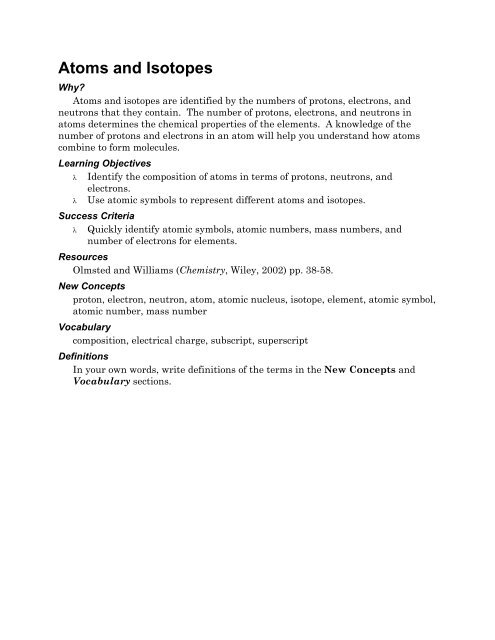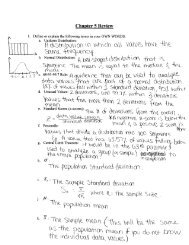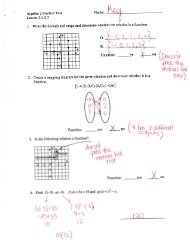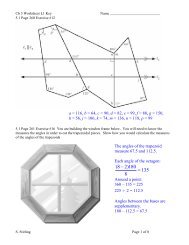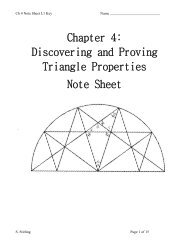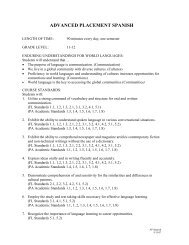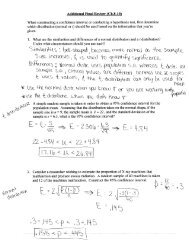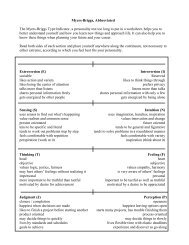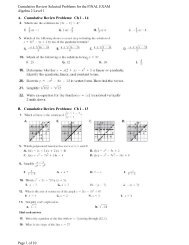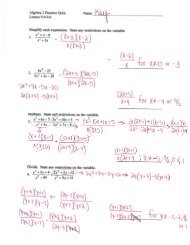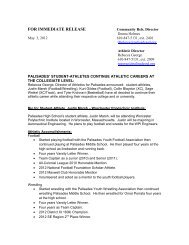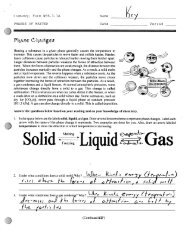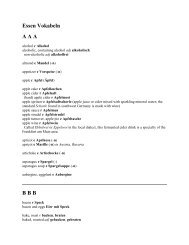You also want an ePaper? Increase the reach of your titles
YUMPU automatically turns print PDFs into web optimized ePapers that Google loves.
Atoms <strong>and</strong> Isotopes<br />
Why?<br />
Atoms <strong>and</strong> <strong>isotopes</strong> are identified by the numbers of protons, electrons, <strong>and</strong><br />
neutrons that they contain. The number of protons, electrons, <strong>and</strong> neutrons in<br />
<strong>atoms</strong> determines the chemical properties of the elements. A knowledge of the<br />
number of protons <strong>and</strong> electrons in an atom will help you underst<strong>and</strong> how <strong>atoms</strong><br />
combine to form molecules.<br />
Learning Objectives<br />
λ Identify the composition of <strong>atoms</strong> in terms of protons, neutrons, <strong>and</strong><br />
electrons.<br />
λ Use atomic symbols to represent different <strong>atoms</strong> <strong>and</strong> <strong>isotopes</strong>.<br />
Success Criteria<br />
λ Quickly identify atomic symbols, atomic numbers, mass numbers, <strong>and</strong><br />
number of electrons for elements.<br />
Resources<br />
Olmsted <strong>and</strong> Williams (Chemistry, Wiley, 2002) pp. 38-58.<br />
New Concepts<br />
proton, electron, neutron, atom, atomic nucleus, isotope, element, atomic symbol,<br />
atomic number, mass number<br />
Vocabulary<br />
composition, electrical charge, subscript, superscript<br />
Definitions<br />
In your own words, write definitions of the terms in the New Concepts <strong>and</strong><br />
Vocabulary sections.
Atoms <strong>and</strong> Isotopes<br />
Model: Two Isotopes of Sodium:<br />
The diagrams below show representations of sodium <strong>isotopes</strong>. Note that the<br />
diameter of an atom is about 10,000 time larger than the diameter of the atomic<br />
nucleus so the relative sizes of the atom <strong>and</strong> the nucleus are not accurately depicted<br />
in these diagrams.<br />
Atomic Symbol Notation<br />
A<br />
X<br />
Z<br />
Mass Number<br />
Atomic Symbol<br />
Atomic Number<br />
Isotope 1<br />
23<br />
Na<br />
11<br />
Nucleus<br />
(11 protons, 12 neutrons)<br />
11 electrons<br />
Isotope 2<br />
24<br />
Na<br />
11<br />
Nucleus<br />
(11 protons, 13 neutrons)<br />
11 electrons<br />
Key Questions<br />
1. What do the two sodium <strong>isotopes</strong> in the model have in common <strong>and</strong> how do they<br />
differ?<br />
2. How is the mass number, A, determined?<br />
3. What information is provided by the atomic number, Z?
Atoms <strong>and</strong> Isotopes<br />
4. What is the relationship between the number of protons <strong>and</strong> the number of<br />
electrons in an atom?<br />
5. Because of the relationship between the number of protons <strong>and</strong> number of<br />
electrons in an atom, what is the electrical charge of an atom?<br />
6. Where are the electrons, protons, <strong>and</strong> neutrons located in an atom?<br />
7. Where is most of the mass located in an atom?<br />
8. What do all sodium <strong>isotopes</strong> have in common that distinguishes them from <strong>atoms</strong><br />
<strong>and</strong> <strong>isotopes</strong> of other elements?<br />
Exercises<br />
1. (a) Write the atomic symbols for two <strong>isotopes</strong> of carbon, one with mass number<br />
12, the other with mass number 13.<br />
(b) Sketch pictures, similar to those in the model, of these two carbon <strong>isotopes</strong>.<br />
2. Construct a model for an atom in which the relative sizes of the nucleus <strong>and</strong> the<br />
atom are represented accurately.
Atoms <strong>and</strong> Isotopes<br />
3. Fill in the missing information in the following table.<br />
Name Symbol Atomic<br />
Number Z<br />
oxygen<br />
16<br />
O<br />
8<br />
Mass<br />
Number A<br />
Number of<br />
Neutrons<br />
Number of<br />
Electrons<br />
8 16 8 8<br />
7 7<br />
34 S<br />
deuterium 1 1<br />
tritium 1 3<br />
9 19<br />
beryllium 9<br />
12 24<br />
12 25<br />
238 92<br />
chlorine 35<br />
17 37<br />
Kr 84 36<br />
26 56<br />
silver 60<br />
70 51<br />
195 117<br />
79 118


